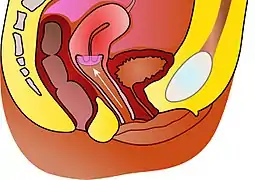diaphragm
English
Etymology
From Ancient Greek διάφραγμα (diáphragma, “partition”), from διά (diá, “across”) and φράγμα (phrágma, “barrier”), from the verb φράσσω (phrássō).
Pronunciation
- IPA(key): /ˈdaɪəˌfɹæm/
Noun
diaphragm (plural diaphragms)
- (anatomy) In mammals, a sheet of muscle separating the thorax from the abdomen, contracted and relaxed in respiration to draw air into and expel air from the lungs; also called thoracic diaphragm.
- (anatomy) Any of various membranes or sheets of muscle or ligament which separate one cavity from another.
- A contraceptive device consisting of a flexible cup, used to cover the cervix during intercourse.
- (mechanics) A flexible membrane separating two chambers and fixed around its periphery that distends into one or other chamber as the difference in the pressure in the chambers varies.
- (acoustics) In a speaker, the thin, semi-rigid membrane which vibrates to produce sound.
- (optics, photography) A thin opaque structure with a central aperture, used to limit the passage of light into a camera or similar device.
- (chemistry) A permeable or semipermeable membrane.
- (construction) A floor slab, metal wall panel, roof panel or the like, having a sufficiently large in-plane shear stiffness and sufficient strength to transmit horizontal forces to resisting systems.
Derived terms
Derived terms
- diaphragmal
- diaphragmic
- diaphragmatic
- diaphragmatically
- interdiaphragm
- diaphragm arch
- diaphragm pump
- diaphragm seal
- diaphragm shutter
- diaphragm valve
- iris diaphragm
Translations
anatomy: sheet of muscle separating thorax from abdomen
|
|
anatomy: separating membrane or sheet of muscle
contraceptive device
|
mechanics: flexible membrane
acoustics: vibrating membrane in a speaker
optics: structure with a central aperture used to limit the passage of light
|
chemistry: permeable or semipermeable membrane
construction: stiff floor slab etc.
- The translations below need to be checked and inserted above into the appropriate translation tables, removing any numbers. Numbers do not necessarily match those in definitions. See instructions at Wiktionary:Entry layout#Translations.
Verb
diaphragm (third-person singular simple present diaphragms, present participle diaphragming, simple past and past participle diaphragmed)
- (optics, photography) To reduce lens aperture using an optical diaphragm.
- To act as a diaphragm, for example by vibrating.
Translations
optics: to reduce lens aperture
|
|
Gallery
 The thoracic diaphragm.
The thoracic diaphragm. A contraceptive diaphragm.
A contraceptive diaphragm..png.webp) A mechanical diaphragm.
A mechanical diaphragm. An acoustic diaphragm.
An acoustic diaphragm.
This article is issued from Wiktionary. The text is licensed under Creative Commons - Attribution - Sharealike. Additional terms may apply for the media files.